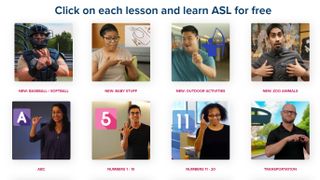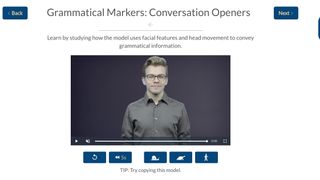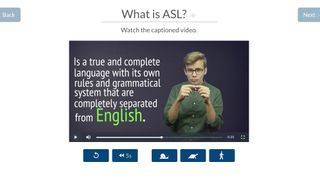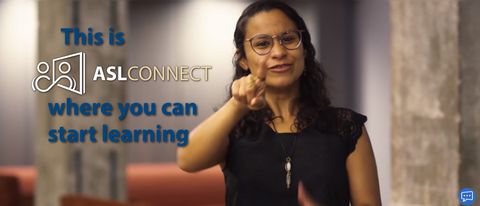ASL Connect is a series of American Sign Language lessons provided by Gallaudet University. The college is located in Washington D.C and has been providing degree-level education for deaf and hard of hearing students since 1864.
There still aren’t many colleges specifically designed for the needs of the deaf community but among them, Gallaudet University is one of the highest ranking and best known – it was even the setting for Netflix’s reality series Deaf U, a show following the lives of a group of students at the school.
The university offers a range of paid-for courses in ASL and Deaf Studies, as well as general academic courses designed for deaf and hard of hearing students. It also provides a basic, free online course for beginners wanting to get started in ASL, which we tried out for this review.
If you're searching for more online resources, we also have a guide to the best online learning platforms. Many of these platforms provide their own ASL courses, alongside plenty of other academic, self-paced classes.
Gallaudet ASL Connect review: Course quality
Gallaudet’s online public programs consist of a set of free introductory videos. The lessons are aimed at complete beginners and split across four main modules - ‘Getting Started’, ‘Basic Personal Information’, ‘Making An Encounter’ and ‘People’. In addition to these lessons, you can also access vocabulary videos, where you can see people signing words surrounding a particular topic.

The ‘Getting Started’ lessons give learners a quick overview of the language and some tips for how to get the most out of the course. ‘Basic Personal Information’ covers greetings and how to introduce yourself, including how to fingerspell your name. ‘Making An Encounter’ covers how to ask questions of others, including discourse markers, which are conversational words that break up conversation and indicate that you are following what’s being said (the spoken English equivalent would be words such as ‘right’, ‘mm’ or ‘okay’).
Elsewhere in the course it covers non-manual markers, which are grammatical and semantic features separate from hand signing, such as raising your eyebrows during a greeting or at the beginning of a conversation. This is a useful addition to the course and highlights how it focuses very much on ASL as a conversational tool – rather than just teaching you the signs, it teaches you how to be an active listener and participant in conversation. It includes tips for producing language rather than just recognising it – for example, the course tells students to use their dominant hand for signing and not swapping between them, something which seems obvious but might be overlooked if you were a beginner.

The ‘People’ module covers how to identify your gender and how to talk about others, their identities and what they are doing. However, it’s worth noting that the course only provides you with ways to either describe yourself as either a man or a woman, so isn’t inclusive of other gender identities. The course also covers how to sign the three main identity terms used in the deaf community - deaf, hearing and hard of hearing.
In addition to the above, Gallaudet offers a variety of online, paid-for ASL courses. These are much more in-depth than any of the free options, with scheduled classes and live tutors available to give you feedback. Most of these courses are worth 1 - 3 credits, with pricing starting at $316 and going up to $950.
Gallaudet ASL Connect review: Teaching format
Each lesson is generally structured in four sections: a video to show you the key words or phrases to learn, a video showing them used in conversation, a comprehension quiz to test what you’ve learned and, in some sections, the option for the course to connect to your webcam so you can see yourself practicing.
The latter section is particularly useful as it allows you to see yourself as someone else would and immerse yourself in something more like a ‘real-world’ conversation, something that is vital to being able to use a language outside of a learning environment.
Lesson objectives and outcomes are clearly defined at the beginning of each lesson, which clearly sets out how the course is structured and what you’re about to learn.

In comparison to some ASL courses, Gallaudet’s course doesn’t include sound in any of the lessons, (although it uses rare instances of closed captioning for clarification). The idea of this, as explained during the introduction, is to avoid you ‘thinking’ in English, instead pushing you to adapt to interpreting and signing in the source language. The issue with courses that use subtitles or dubbing for each phrase is that course participants may rely too much on them for translation, so struggle to pick up the source language. At first this seems a little daunting, but after a few videos it becomes natural and does, overall, seem to make it slightly easier to pick up ASL as you’re not constantly looking for a direct spoken English translation.
The paid-for online courses are much more like typical classes, albeit in an online environment. Students are expected to participate in the classes through sign language, and to produce recorded video-based assignments as well.
Gallaudet ASL Connect review: Cost
The basic introductory course, which includes the four modules covered here, is completely free as an online, self-paced course. For those wanting more in-depth or credit bearing options, more advanced online courses range from $316 (1 credit) - $950 (3 credits) and include direct feedback from instructors.
This is significantly more than other courses we've reviewed. Sign It, for example, costs $159.99 for access to the full course, and ASLdeafined is $36 for a year's access. However, neither of these platforms are offering the chance to sign with a group of learners and receive 1:1 feedback.
Gallaudet ASL Connect review: Ease of use
All courses are available online through a simple sign-up process and you’re not required to include any payment details if you just want to take the free course.
The lessons are navigated with a simple ‘back’ and ‘next’ structure, however there’s no lesson menu once you’re in the lessons themselves, making it slightly difficult to flick back and forward if you wanted to check something from a few slides ago. We also found that the videos can take a while to load, which might prove annoying for anyone without a fast internet connection.
Gallaudet ASL Connect review: Is it worth it?
For a free course, the Gallaudet ASL Connect lessons are great value and cover all the basics you would need in a simple conversation where you introduce yourself and ask questions of others. It also focuses on grammar and how to construct sentences as well as including practice of non-manual markers, meaning you get a well-rounded understanding of ASL and how it is used in social interactions.
The free course is aimed at complete beginners, so would probably not be suitable for those who have had a few ASL lessons previously. However, it’s a great option for those wanting to try ASL lessons out before committing to a paid-for version of a course. Gallaudet's approach, of combining vocabulary lessons with a greater understanding of deaf culture and interactive speaking, put them ahead of other platforms in this area. Plus, those paid-for courses will allow you to get direct feedback from ASL experts.


